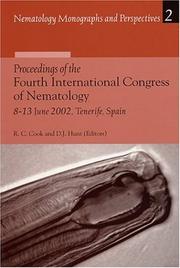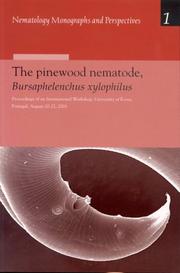| Listing 1 - 10 of 79 | << page >> |
Sort by
|
Book
Year: 2008 Publisher: [Riverdale, Md.?] : U.S. Dept. of Agriculture, Animal and Plant Health Inspection Service,
Abstract | Keywords | Export | Availability | Bookmark
 Loading...
Loading...Choose an application
- Reference Manager
- EndNote
- RefWorks (Direct export to RefWorks)
Book
Year: 1968 Publisher: Washington, D.C. : U.S. Dept. of Agriculture, Agricultural Research Service,
Abstract | Keywords | Export | Availability | Bookmark
 Loading...
Loading...Choose an application
- Reference Manager
- EndNote
- RefWorks (Direct export to RefWorks)
Book
ISBN: 012417180X 0124171613 Year: 2015 Publisher: Amsterdam, [Netherlands] : Academic Press,
Abstract | Keywords | Export | Availability | Bookmark
 Loading...
Loading...Choose an application
- Reference Manager
- EndNote
- RefWorks (Direct export to RefWorks)
Book
Year: 2006 Publisher: [Riverdale, Md.?] : USDA, APHIS,
Abstract | Keywords | Export | Availability | Bookmark
 Loading...
Loading...Choose an application
- Reference Manager
- EndNote
- RefWorks (Direct export to RefWorks)

ISBN: 9789004475236 9789004139213 Year: 2004 Publisher: Leiden;Boston BRILL
Abstract | Keywords | Export | Availability | Bookmark
 Loading...
Loading...Choose an application
- Reference Manager
- EndNote
- RefWorks (Direct export to RefWorks)
Nematode diseases of plants --- Nematodes --- Plant nematodes
Book
ISBN: 9789004387584 9789004366343 Year: 2021 Publisher: Leiden;Boston BRILL
Abstract | Keywords | Export | Availability | Bookmark
 Loading...
Loading...Choose an application
- Reference Manager
- EndNote
- RefWorks (Direct export to RefWorks)
Root-knot nematodes of the genus Meloidogyne represent one of the most damaging and agricultural important group of plant-parasitic nematodes. These nematodes are obligate sedentary endoparasites infecting most species of higher plants and have a cosmopolitan distribution. Annual worldwide economic losses due to nematode infection of crops have been estimated at several hundred billion US dollars. This book is the first complete illustrated compendium of root-knot nematode species and contains 98 species descriptions with comprehensive diagnoses, information on biology, plant-hosts, pathogenicity, symptoms, distribution and biochemical and molecular diagnostics. It also includes introductions into morphology, biology, biogeography, genomics, phylogeny and host-parasite relationships of root-knot nematodes.
Book
ISBN: 9780323913225 0323913229 9780323912266 0323912265 Year: 2023 Publisher: Kidlington, England : Academic Press, an imprint of Elsevier,
Abstract | Keywords | Export | Availability | Bookmark
 Loading...
Loading...Choose an application
- Reference Manager
- EndNote
- RefWorks (Direct export to RefWorks)
Nematode Diseases of Crops and their Sustainable Management focuses on methods to recognize and identify nematode attackers in agriculturally important crops, offering ecologically sustainable and economically viable strategies and measures for the management of nematode infestations and diseases. The book analyzes nematode pests as major constraints in global crop production and explores the limitations of existing nematode management technologies. It offers comprehensive information through individually focused chapters on major nematode problems in internationally important food, fiber and beverage crops as well as in mushrooms, polyhouse agriculture and forest flora with regard to distribution, and much more. In view of the highly damaging nature of the disease complexes and complexity in their management, independent chapters on nematode-fungus and nematode-bacteria disease complexes and their management are also presented.
Nematode diseases of plants --- Agricultural pests --- Plant diseases --- Plant nematodes --- Control. --- Nematode diseases of plants.
Periodical
ISSN: 09576797 Publisher: Wallingford : CAB international,
Abstract | Keywords | Export | Availability | Bookmark
 Loading...
Loading...Choose an application
- Reference Manager
- EndNote
- RefWorks (Direct export to RefWorks)
Plant nematodes --- Plant nematodes --- Nematode diseases of plants --- Nematode Infections. --- Plant Diseases. --- Nematode diseases of plants. --- Plant nematodes. --- Plants --- Plants --- Parasites --- Roundworms --- Bibliographies
Book
ISBN: 0890541256 Year: 1992 Publisher: Saint Paul APS press
Abstract | Keywords | Export | Availability | Bookmark
 Loading...
Loading...Choose an application
- Reference Manager
- EndNote
- RefWorks (Direct export to RefWorks)
Soybean cyst nematode --- Soybean --- Control --- Diseases and pests

ISBN: 9789047413097 9789004132672 Year: 2004 Publisher: Leiden;Boston BRILL
Abstract | Keywords | Export | Availability | Bookmark
 Loading...
Loading...Choose an application
- Reference Manager
- EndNote
- RefWorks (Direct export to RefWorks)
According to the European Plant Protection Organization, the pinewood nematode (PWN), Bursaphelenchus xylophilus is a quarantine organism at the top of the list of the pathogenic species. PWN may be found in North America (Canada, USA and Mexico) and in East Asia (Japan, Korea, China and Taiwan) and has a highly destructive capability towards conifers, in a relatively short time, causing serious economic damage in Japan, China and Korea. This nematode surveying is extremely important and a correct identification of nematode species associated with conifers is essential. Several conifers species are very susceptible (Pinus sylvestris, Pinus nigra and Pinus pinaster), the last one (maritime pine) is a particulary important economic specie in Portugal, and in southern Europe. In 1999, this nematode was found and identified for the first time in Portugal and in Europe. During 1999 and 2000, the Portuguese government, following an alert provided to European Community officials initiated an extensive national survey. During 2000 and 2001, research has been carried out regarding the morphobiometric as well as molecular (DNA: ITS-RFLP) characterization of the collected populations, as well as closely related species of Bursaphelenchus. The book details the Proceedings of an international workshop held at the University of Évora in 2001, covering all major aspects of the bioecology of the pinewood nematode (PWN), Bursaphelenchus xylophilus, its insect vectors and effects on the tree. Topics covered are: global issues and national surveys; morphology and molecular methods of identification of PWN; ecology and epidemiology; quarantine issues; tree physiology, resistance and histopathology; biology of PWN and relationships to its cerambycid vectors; control methods. General quarantine and political views are also presented.
Conifer wilt --- Pine --- Pinewood nematode --- Diseases and pests
| Listing 1 - 10 of 79 | << page >> |
Sort by
|

 Search
Search Feedback
Feedback About UniCat
About UniCat  Help
Help News
News